Lepisiota frauenfeldi (Mayr)
 List as in Bolton (1995:
227) - List as in Bolton (1995:
227) -
Type location Croatia (Hypoclinea frauenfeldi,
Mayr, 1855: 378, worker; Roger, 1859: 243, queen; Emery, 1878b: 46,
male) - no type images on Antweb (September 2015).
junior synonyms
azerbeidzhanica
(Acantholepis frauenfeldi Mayr
var. azerbeidzhanica nov.,
Karavaiev, 1932: 250, illustrated, worker; synonymy Arakelian, 1994:
81) from Azerbaijan
caucasica
(Acantholepis Frauenfeldi Mayr
var. caucasica n. v.,
Santschi, 1917d: 43, worker; species in Agosti & Collingwood,
1987a: 57; synonymy Arakelian, 1994: 81) from Caucasus
subspecies
aegyptiaca (Acantholepis frauenfeldi var. aegyptiaca nov., Finzi, 1936:
184, illustrated, worker) from Egypt
atlantis
(Acantholepis Frauenfeldi Mayr
v. atlantis n. v., Santschi,
1917d: 42, worker & queen) from Algeria
barbara (Acantholepis Frauenfeldi Mayr v. barbara n. v., Santschi, 1917d: 44,
illustrated,worker) from Tunisia
bipartita
(Formica bipartita, F Smith,
1861a: 33, worker; André, 1882b: 211, queen; Karavaiev,
1910b: 44, male) from Lebanon
ferganica
(Acantholepis frauenfeldi ferganica
nov. subsp., Kuznetsov-Ugamsky, 1929c: 490, illustrated, worker) from Turkestan
integra (Acantholepis frauenfeldi Mayr var. A. integra n. var., Forel, 1894c:
411, in
key,
worker) from India
kantarensis
(Acantholepis Frauenfeldi Mayr
v. kantarensis n. var.,
Forel, 1911d: 351, worker) from Algeria
kassansai
(Acantholepis frauenfeldi kassansai
ssp. nov., Tarbinsky, 1976: 132, illustrated, worker; in Russian) from Kirgizia
libanica (Acantholepis Frauenfeldi Mayr
v. libanica n. v., Santschi,
1921a: 115,
worker) from Syria
marocana
(Acantholepis frauenfeldi Mayr
v. marocana n. v.,
Santschi, 1936c: 206, illustrated, worker - unavailable) from Morocco
opaciventris (Acantholepis frauenfeldi var. opaciventris nov., Finzi, 1936:
187, illustrated, worker) from Egypt
pubescens
(Acantholepis frauenfeldi var.
pubescens nov., Forel,
1892a: 41, in key, worker) from Tunisia
saharensis (Acantholepis Frauenfeldi Mayr
stirps saharensis n. st.,
Santschi, 1917d:
44,
illustrated, worker) from Algeria
surchanica
(Acantholepis frauenfeldi surchanica
subsp. nov., Kuznetsov-Ugamsky, 1929c: 491, illustrated, worker) from Turkestan
truncata (Acantholepis Frauenfeldi Mayr
stirps integra For. v. truncata n. var., Santschi, 1917d:
44, worker; Finzi, 1940: 162, worker & queen) from Tunisia
variabilis
(Acantholepis Frauenfeldi Mayr
v. variabilis n. v.,
Santschi, 1917d: 43, worker) from Tunisia
velox (Acantholepis Frauenfeldi Mayr
stirps integra For. v. velox n. var., Santschi,
1917d: 44, worker; Baroni Urbani, 1968b: 480, all forms) from Tunisia
all forms described (see Bingham, 1903: 316; Santschi, 1917d: 42; H
Tohmé, 1981: 1; and Atanassov & Dulssky, 1992: 205).
This list quite clearly is wholly misleading and the
"species" is in a highly confused and poorly differentiated state.
Simply on the basis of historic descriptions and illustrations, I have
attempted to bring some clarity and, hence, this analysis page. The
links are to the key sections below.
|
Lepisiota semenovi (Ruzky) - no type images on Antweb
(September 2015)
 List as in Bolton (1995:
228) - List as in Bolton (1995:
228) -
Type location Russia (Acantholepis frauenfeldi var. semenovi nov. var, Ruzky, 1905b: 461,
worker; ssp
of frauenfeldi in Kuznetsov-Ugamsky, 1929c: 485; raised to
species Pisarski, 1967: 410 & Dlussky & Zabelin, 1985: 235)
junior synonyms
(all originally described as varieties of frauenfeldi;
apparently due to Dlussky & Zabelin, 1985: 163-165 or Dlussky,
Soyunov & Zabelin, 1990: 163)
arnoldovi
(Acantholepis frauenfeldi var. arnoldovi
nov. var., Ruzky, 1905b: 462, worker) from Turkestan
coriacea
(A. frauenfeldi coriacea nov.
subsp., Kuznetsov-Ugamsky, 1929c: 487,
illustrated, worker) from Turkestan
deserticola (A. fr.deserticola,
Kuznetsov-Ugamsky,
1929c: 485, illustrated, worker) from Turkestan
halinae (A. frauenfeldi halinae subsp. nov.,
Kuznetsov-Ugamsky, 1929c: 489,
illustrated, worker) from Turkestan
integrisquama
(A. frauenfeldi integrisquama nov. subsp.,
Kuznetsov-Ugamsky, 1929c: 486, illustrated, worker) from Turkestan
karawaiewi (st melas
var karawaiewi, Sanstchi, 1917d: 44; Kuznetsov-Ugamsky, 1929c:
483, worker; raised to species Pisarski, 1967) from Turkestan
latisquama (A. frauenfeldi latisquama nov.
subsp., Kuznetsov-Ugamsky, 1929c:
487, illustrated, worker) from Turkestan
litoralis
(A. fr. litoralis,
Kuznetsov-Ugamsky, 1929c: 488, illustrated, worker) from Turkestan
mediorubra (A. frauenfeldi mediorubra nov.
subsp., Kuznetsov-Ugamsky,
1929c: 486, illustrated, worker) from Turkestan
spinisquama (A. frauenfeldi spinisquama nov.
subsp., Kuznetsov-Ugamsky, 1929c:
483, illustrated, worker; raised to species Pisarski, 1967: 41; most
recent useage Lepisiota spinisquama
by Collingwood & Agosti, 1996: 369) from Turkestan - now ? Uzbekistan
transcaspiensis
(A. frauenfeldi Mayr v. transcaspiensis n. var.,
Santschi, 1917d: 43, worker; Karavaiev, 1926e: 188, queen
& male)
turkmena (A. frauenfeldi turkmena nov. subsp.,
Kuznetsov-Ugamsky, 1929c:
488, illustrated, worker) from Turkestan
unavailable names
infumata (A. frauenfeldi turkmena var. infumata nov. var.,
Kuznetsov-Ugamsky, 1929c: 489, worker) from Turkestan (no
images on Antweb, September 2015)
minuta (A. frauenfeldi karawajewi Santschi,
1917, var. minuta nov. var., Kuznetsov-Ugamsky, 1929c:
484, illustrated, worker) from Turkestan;
worker only described (no images on Antweb, September 2015)
|
| Petioles with smoothly rounded sides |
| ¤ |
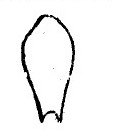 Petiole
scale with summit simply pointed - North Africa (Sahara desert) - saharensis Petiole
scale with summit simply pointed - North Africa (Sahara desert) - saharensis |
| ¤ |
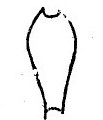 Petiole with smoothly curved sides and with a quite
deeply impressed summit (in anterior view), but elongated with the
apical corners spinose or sharply dentate - North Africa - barbara Petiole with smoothly curved sides and with a quite
deeply impressed summit (in anterior view), but elongated with the
apical corners spinose or sharply dentate - North Africa - barbara
|
| ¤ |
 Petiole with smoothly curved sides and with a quite deeply
impressed summit (in anterior view), the apical corners essentially
obtuse - Southern Europe - frauenfeldi-group Petiole with smoothly curved sides and with a quite deeply
impressed summit (in anterior view), the apical corners essentially
obtuse - Southern Europe - frauenfeldi-group |
| ¤ |
 Petiole usually wider, the sides smoothly curved with
widest part in upper one-third, and with the summit no more than
shallowly impressed, the corners bluntly rounded; head in full-face
view sub-ovoid with near straight occiput - east-central Asia - semenovi-group Petiole usually wider, the sides smoothly curved with
widest part in upper one-third, and with the summit no more than
shallowly impressed, the corners bluntly rounded; head in full-face
view sub-ovoid with near straight occiput - east-central Asia - semenovi-group |
| Petioles with angular sides |
| ¤ |
 with distinctly angular sides but with the petiole as
wide as it is high and a quite deeply impressed summit, the apical
corners with acute angles - eastern Mediterranean & east-central
Asia - bipartita-group with distinctly angular sides but with the petiole as
wide as it is high and a quite deeply impressed summit, the apical
corners with acute angles - eastern Mediterranean & east-central
Asia - bipartita-group |
| ¤ |
 Petiole with distinctly angular sides but with the petiole
width only about 40% of the height and a deeply impressed summit, the
apical corners with acute angles - eastern Mediterranean &
east-central Asia - karawaiewi-group Petiole with distinctly angular sides but with the petiole
width only about 40% of the height and a deeply impressed summit, the
apical corners with acute angles - eastern Mediterranean &
east-central Asia - karawaiewi-group |
| ¤ |
Petiole usually wider
and with
the summit no more than shallowly impressed, the corners bluntly
rounded - North Africa (Tunisia) - velox-group |
| Petioles with broadly angular sides and straight
summits |
| ¤ |
 Petiole
usually wider and with the summit near straight or very shallowly
impressed, sides angular, the corners sub-rectangular; propodeum
spinose; all with silky appearance - South-central Asia and Indian
subcontinent - sericea-group Petiole
usually wider and with the summit near straight or very shallowly
impressed, sides angular, the corners sub-rectangular; propodeum
spinose; all with silky appearance - South-central Asia and Indian
subcontinent - sericea-group |
| ¤ |
 Petiole
summit straight or nearly so - South-central Asia and Indian
subcontinent - kassansai (Kirgizia), integra
(Indian subcontinent Petiole
summit straight or nearly so - South-central Asia and Indian
subcontinent - kassansai (Kirgizia), integra
(Indian subcontinent |
|
Provisional key to separate species of moderately
elongated Lepisiota from southern Europe, North Africa and
East-Central Asia.
|
The Kuznetsov-Ugamsky (1929c) index of petiole
dimensions
seems useful, although not covering all species, and is cited as
KI b/a - f/a - g/c - e/d
|
| ¤ |
 (Acantholepis
frauenfeldi Mayr v. marocana n. v.,
Santschi, 1936c: 206, illustrated, worker) from Morocco - see http://www.antweb.org/specimenImages.do?code=casent0912384 (Acantholepis
frauenfeldi Mayr v. marocana n. v.,
Santschi, 1936c: 206, illustrated, worker) from Morocco - see http://www.antweb.org/specimenImages.do?code=casent0912384
Santschi's (1936a) description of marocana is on 
|
[ssp of frauenfeldi in
Bolton, 1995]
Morocco - marocana |
| ¤ |
  TL 2.3 mm; petiole scale with dorsal border
lightly incised; separable from type frauenfeldi by head
narrowing less anteriorly with the type the head is almost oval in aegyptiaca
it is elongated; (Acantholepis frauenfeldi var aegyptiaca
nov.,
Finzi, 1936: 184, illustrated, worker) from Egypt TL 2.3 mm; petiole scale with dorsal border
lightly incised; separable from type frauenfeldi by head
narrowing less anteriorly with the type the head is almost oval in aegyptiaca
it is elongated; (Acantholepis frauenfeldi var aegyptiaca
nov.,
Finzi, 1936: 184, illustrated, worker) from Egypt
Finzi's (1936) description of aegyptiaca is on 
|
Raised to species
new status
[ssp
of frauenfeldi in Bolton, 1995]
Egypt - aegyptiaca |
| ¤ |
 TL 2.8 mm; wholly opaque black, part of
mesonotum dorsum shiny, gaster silky with blueish reflections, of the sericea
type but head narrower, appendages yellow, scape of the bipartita type;
propodeum weakly spined; head elongated with anterior of sides
sub-parallel and a little wider than the alitrunk; a few erect hairs on
the head and segment margins of gaster; (Acantholepis frauenfeldi
var opaciventris nov., Finzi, 1936: 187, illustrated, worker)
from Egypt - no type images
on Antweb (October 2014) TL 2.8 mm; wholly opaque black, part of
mesonotum dorsum shiny, gaster silky with blueish reflections, of the sericea
type but head narrower, appendages yellow, scape of the bipartita type;
propodeum weakly spined; head elongated with anterior of sides
sub-parallel and a little wider than the alitrunk; a few erect hairs on
the head and segment margins of gaster; (Acantholepis frauenfeldi
var opaciventris nov., Finzi, 1936: 187, illustrated, worker)
from Egypt - no type images
on Antweb (October 2014)
Finzi's (1936) description of opaciventris is on 
May be a simple junior synonym of Lepisiota gracilicornis.
|
[ssp of frauenfeldi in
Bolton, 1995]
Egypt - opaciventris |
| ¤ |
(Acantholepis
frauenfeldi (Mayr) var arnoldovi nov. var., Ruzky, 1905b:
462, worker, in Russian) from Turkestan
- no images on Antweb (October 2014)
4128 Ruzsky, M. 1905. [The ants of Russia.] (Formicariae Imperii
Rossici.) Tr. Obshch. Estest. Imp. Kazansk. Univ. 38: 1-800. |
[ssp
of semenovi in Bolton, 1995]
Turkestan - arnoldovi |
| ?? |
 TL
3.2-4.0 mm;
mesonotum wider (than type frauenfeldi); more abundant and
coarser pubescence; black and shiny (from Forel, 1892a) TL
3.2-4.0 mm;
mesonotum wider (than type frauenfeldi); more abundant and
coarser pubescence; black and shiny (from Forel, 1892a)
(Acantholepis Frauenfeldi Mayr var. pubescens n. var.,
Forel, 1892a:
41, in key, worker; stirps of frauenfeldi, Santschi, 1917d: 43)
from Tunisia
|
[ssp of frauenfeldi in
Bolton, 1995]
Tunisia - pubescens |
| . |
. |
. |
| 1 |
Petiole
scale in
anterior view elongated, dorsal border edentate rounded, straight or
slightly convex |
2 |
| -- |
Petiole scale in anterior
view with
dorsal border dentate to spinose |
10 |
| 2 |
  Brief description: petiole
scale in anterior view with dorsal border reduced so effectively
absent; TL 3.0-3.3 mm; smooth and shiny; generally red with base of
gaster rust, remainder of gaster black - see http://www.antweb.org/specimenImages.do?code=casent0912385 Brief description: petiole
scale in anterior view with dorsal border reduced so effectively
absent; TL 3.0-3.3 mm; smooth and shiny; generally red with base of
gaster rust, remainder of gaster black - see http://www.antweb.org/specimenImages.do?code=casent0912385
(Santschi, 1917d: 44, illustrated, worker) from Algeria
|
[ssp
of frauenfeldi in Bolton, 1995]
Algeria - saharensis |
| -- |
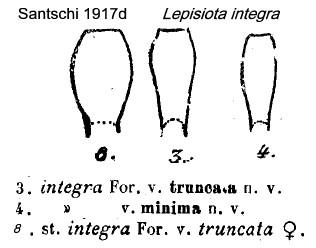 Petiole
scale in anterior view with obvious dorsal margin Petiole
scale in anterior view with obvious dorsal margin |
3 |
| 3 |
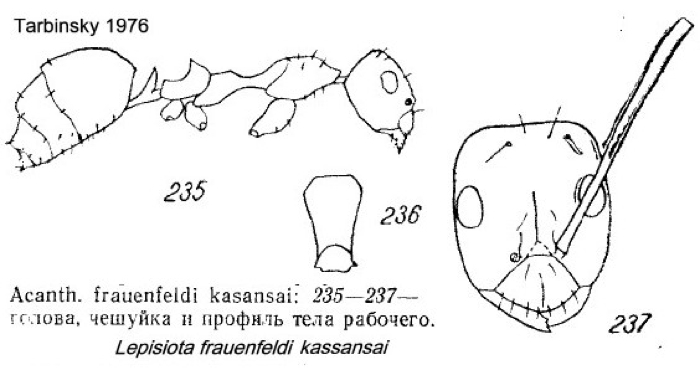 Petiole
with angles close to dorsum; head elongate Petiole
with angles close to dorsum; head elongate
(Tarbinsky, 1976: 132, illustrated, worker; in Russian) from Kirgizia - no images on Antweb
(October 2014)
Tarbinsky's (1976) description is at  . . |
[ssp
of frauenfeldi in Bolton, 1995]
Kirgizia - kassansai |
| -- |
Petiole without angles or
angles near
mid-point of petiole sides; head relatively short and square to oval |
4 |
| 4 |
 Wholly
black other than appendages; shiny; TL 3.0-3.2 mm; head somewhat oval;
scapes surpass occiput by > 3/5 of own length; propodeum bispinose;
petiole without spines; partly shiny and partly opaque (reticulated);
black with appendages brownish-yellow (Forel, 1894c: 411, in key,
worker; race L. frauenfeldi race integra in Forel
1906b: 86 - "form derived from the palearctic fauna") from India. See http://www.antweb.org/specimenImages.do?code=casent0909888 Wholly
black other than appendages; shiny; TL 3.0-3.2 mm; head somewhat oval;
scapes surpass occiput by > 3/5 of own length; propodeum bispinose;
petiole without spines; partly shiny and partly opaque (reticulated);
black with appendages brownish-yellow (Forel, 1894c: 411, in key,
worker; race L. frauenfeldi race integra in Forel
1906b: 86 - "form derived from the palearctic fauna") from India. See http://www.antweb.org/specimenImages.do?code=casent0909888
Forel's (1894c) key with a short description of integra is at  . .
|
[ssp
of frauenfeldi in Bolton, 1995]
Indian subcontinent - integra |
| -- |
Variably coloured but not
wholly black
other than appendages |
5 |
| 5 |
Overall
appearance
silky |
sericea-group
(?) - 6 |
| -- |
Overall appearance shiny
on almost all
of head, alitrunk and gaster |
7 |
|
Appearance
generally finely sculptured and silky |
. |
| 6 |
 TL
3.0-3.5 mm; head flatter and wider, especially posteriorly (than type frauenfeldi);
subopaque and silky; dark brown; propodeum bispinose TL
3.0-3.5 mm; head flatter and wider, especially posteriorly (than type frauenfeldi);
subopaque and silky; dark brown; propodeum bispinose
(Acantholepis frauenfeldi var sericea, Forel, 1892a: 41,
diagnosis in key , worker; raised to species by Pisarski, 1967: 408);
Menozzi (1939a: 312, 339) recorded findings in India - see http://www.antweb.org/specimenImages.do?code=casent0909885
|
 [sp sericea in
Bolton, 1995] [sp sericea in
Bolton, 1995]
Indian subcontinent - sericea |
| -- |
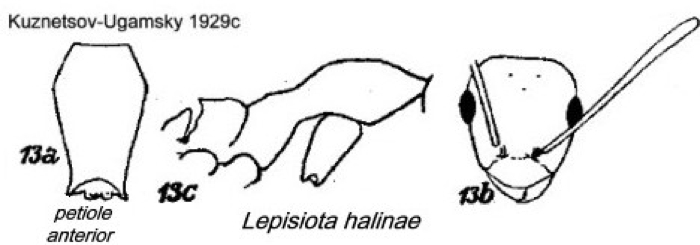 TL
2.7-3.0 mm; head dark brown, antennae, alitrunk and petiole dusky
red-brown, gaster black; KI 0.53 - 1.57 - 0.10 - 0.47 TL
2.7-3.0 mm; head dark brown, antennae, alitrunk and petiole dusky
red-brown, gaster black; KI 0.53 - 1.57 - 0.10 - 0.47
(Acantholepis frauenfeldi halinae subsp. nov.,
Kuznetsov-Ugamsky, 1929c: 489, illustrated, worker; synonymised with sericea
by Pisarski, 1967: 408; with semenovi by Dlussky, Soyunov &
Zabelin, 1990: 165) from Turkestan
- see http://www.antweb.org/specimenImages.do?code=casent0912404
Kuznetsov-Ugamsky's (1929c) description of halinae is on 
|
[ssp of semenovi
in Bolton, 1995]
Turkestan - halinae |
|
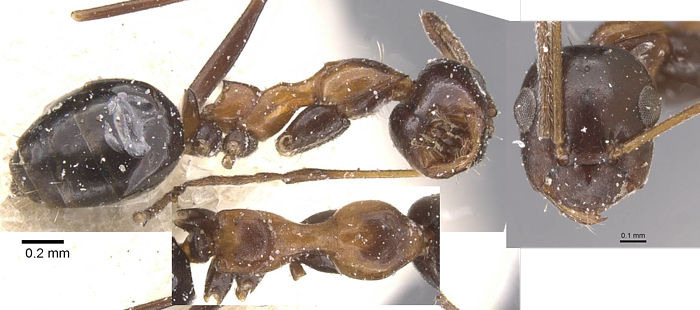
|
|
| -- |
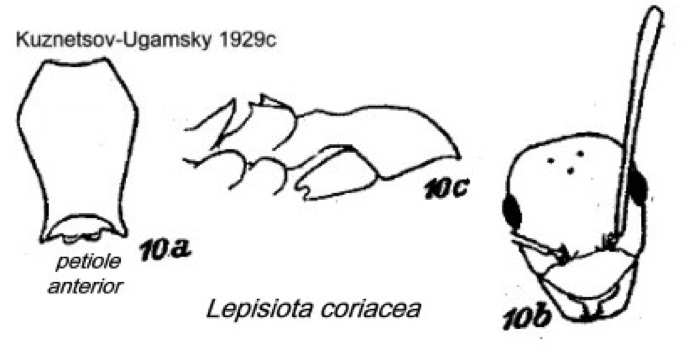 TL
2.7-3.9 mm; head near square; head and alitrunk matt due to microscopic
granulation; overall black, alitrunk sometimes slightly reddish; KI
0.60 - 1.27 - 0.125 - 0.67 TL
2.7-3.9 mm; head near square; head and alitrunk matt due to microscopic
granulation; overall black, alitrunk sometimes slightly reddish; KI
0.60 - 1.27 - 0.125 - 0.67
(Acantholepis frauenfeldi coriacea nov. subsp.,
Kuznetsov-Ugamsky, 1929c: 487, illustrated, worker; synonymised with semenovi
by Dlussky, Soyunov & Zabelin, 1990: 165) from Turkestan - see http://www.antweb.org/specimenImages.do?code=casent0912403
Kuznetsov-Ugamsky's (1929c) description of coriacea is on 
|
[ssp
of semenovi in Bolton, 1995]
Turkestan - coriacea |
|
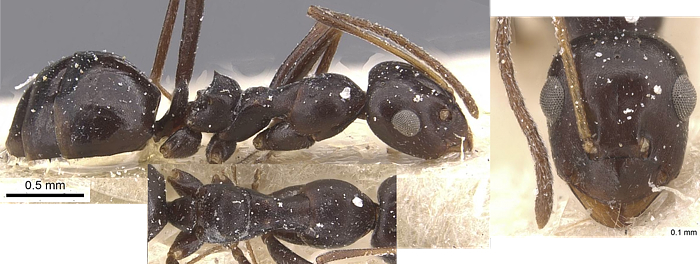
|
|
| -- |
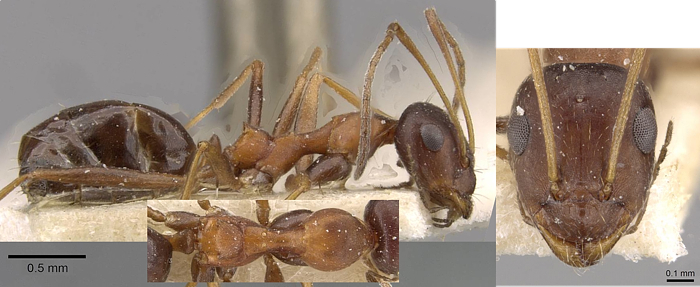 TL
2.8-3.5
mm; head and alitrunk subopaque to matt and densely reticulate or
reticulo-punctate; gaster shiny, more feebly shagreened TL
2.8-3.5
mm; head and alitrunk subopaque to matt and densely reticulate or
reticulo-punctate; gaster shiny, more feebly shagreened
(Acantholepis Frauenfeldi Mayr v. Kantarensis n. var.,
Forel, 1911d:
351, worker) from Algeria -
see http://www.antweb.org/specimenImages.do?code=casent0909886
Forel's (1911d) description of kantarensis is at  . .
|
[ssp of frauenfeldi
in Bolton, 1995]
Algeria - kantarensis |
|
Appearance
generally shiny |
. |
| 7 |
Alitrunk
variably red |
North
Africa - velox-group - 8 |
| -- |
Alitrunk variable usually
darker |
Central
Asia - semenovi-group
- 9 |
| 8 |
 TL
3.2-3.7 mm; smooth or very finely reticulate and shiny; mid-alitrunk,
base of petiole, antennae, articulations of legs and tarsi rust, gaster
black; nest preference in sandy soil; rapid mover TL
3.2-3.7 mm; smooth or very finely reticulate and shiny; mid-alitrunk,
base of petiole, antennae, articulations of legs and tarsi rust, gaster
black; nest preference in sandy soil; rapid mover
(Acantholepis frauenfeldi stirps
integra v. velox n. var., Santschi, 1917d: 44,
worker, brief description; Baroni Urbani,
1968b: 480, all forms [unavailable]) from Tunisia - see http://www.antweb.org/specimenImages.do?code=casent0912388
Baroni Urbani's (1968b) observations are on 
|
[ssp
of frauenfeldi in Bolton, 1995]
Tunisia - velox |
| -- |
 TL
2.6-2.8 mm; generally as velox but smaller; from same
environment TL
2.6-2.8 mm; generally as velox but smaller; from same
environment
(Acantholepis frauenfeldi stirps
integra
var. truncata n.
var., Santschi, 1917d: 44, worker;
Finzi, 1940: 162, worker & queen) from Tunisia - see http://www.antweb.org/specimenImages.do?code=casent0912386
|
[ssp of frauenfeldi
in Bolton, 1995]
Tunisia & Libya - truncata |
|

|
|
| -- |
 TL
1.6-2.2 mm; generally darker and always much smaller; montane species TL
1.6-2.2 mm; generally darker and always much smaller; montane species
(Acantholepis frauenfeldi stirps integra var minima
n. var.,
Santschi, 1917d: 45, illustrated, worker (petiole above)) from Tunisia - see https://www.antweb.org/specimenImages.do?code=casent0912382
|
[ssp
of frauenfeldi in Bolton, 1995
- listed as unavailable name]
Tunisia - minima |
|
Alitrunk variably but mainly dark - semenovi-group |
. |
| 9 |
TL 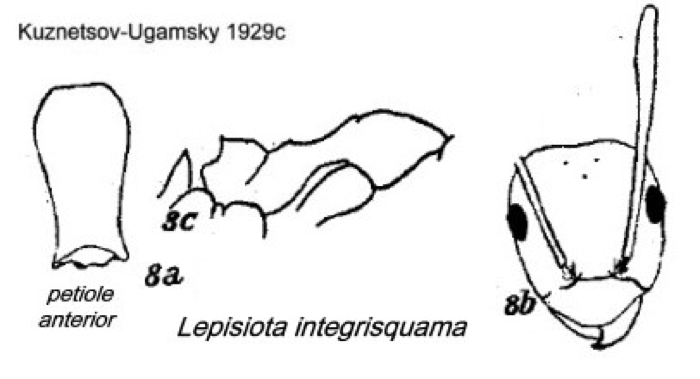 2.5-3.0 mm; head a long
oval; whole body with extensive
protruding pilosity, also with fine, microscopic
granulation, finer on the gaster, semi-matt; generally black, with
reddish patches on the alitrunk; KI 0.64 - 1.60 - 0.0 - 0.38 2.5-3.0 mm; head a long
oval; whole body with extensive
protruding pilosity, also with fine, microscopic
granulation, finer on the gaster, semi-matt; generally black, with
reddish patches on the alitrunk; KI 0.64 - 1.60 - 0.0 - 0.38
(Acantholepis frauenfeldi integrisquama nov. subsp.,
Kuznetsov-Ugamsky, 1929c: 486, illustrated, worker); junior synonym of semenovi,
Dlussky, Soyunov & Zabelin, 1990: 165) from Turkestan - no images on Antweb
(October 2014)
Kuznetsov-Ugamsky's (1929c) description of integrisquama is on 
|
[ssp
of semenovi in Bolton, 1995]
Turkmenistan - integrisquama |
| -- |
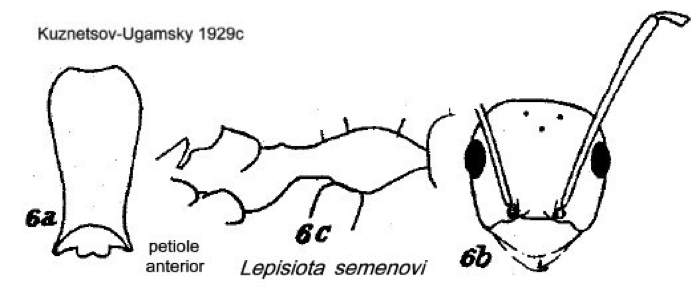 TL
2.6-3.5 mm; head square; with sparse erect pilosity; very
finely microscopically reticulate but shiny; gaster black or
black-brown, alitrunk red or yellow-red also most of legs, head and
coxae dark red; KI 0.65 - 1.58 - 0.0 - 0.23 from Turkestan TL
2.6-3.5 mm; head square; with sparse erect pilosity; very
finely microscopically reticulate but shiny; gaster black or
black-brown, alitrunk red or yellow-red also most of legs, head and
coxae dark red; KI 0.65 - 1.58 - 0.0 - 0.23 from Turkestan
(Acantholepis frauenfeldi var semenovi nov. var, Ruzky,
1905b:
461, worker; ssp of frauenfeldi in Kuznetsov-Ugamsky, 1929c:
485; raised to species Pisarski, 1967: 410 - without comments - &
Dlussky & Zabelin, 1985: 235 - unavailable as HNS No is wrong) - no
type images on Antweb (October 2014)
Kuznetsov-Ugamsky's (1929c) description (from Ruzsky, 1905) of semenovi
is on 
|
 [sp semenovi in
Bolton, 1995] [sp semenovi in
Bolton, 1995]
Turkmenistan - semenovi |
| -- |
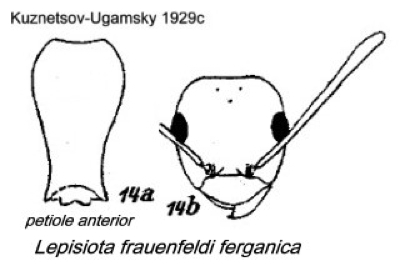 TL
3.0-3.5 mm; overall black, alitrunk with scattered redder areas;
appendages brown-red, base of scapes and tarsi lighter; KI 0.56 - 1.56
- 0.05 - 0.39 TL
3.0-3.5 mm; overall black, alitrunk with scattered redder areas;
appendages brown-red, base of scapes and tarsi lighter; KI 0.56 - 1.56
- 0.05 - 0.39
(Acantholpeis frauenfeldi ferganica nov. subsp.,
Kuznetsov-Ugamsky, 1929c: 490, illustrated, worker) from Turkestan - see http://www.antweb.org/specimenImages.do?code=casent0912381
Kuznetsov-Ugamsky's (1929c) description of ferganica is on 
|
[ssp
of frauenfeldi in Bolton, 1995]
Turkestan - ferganica |
|
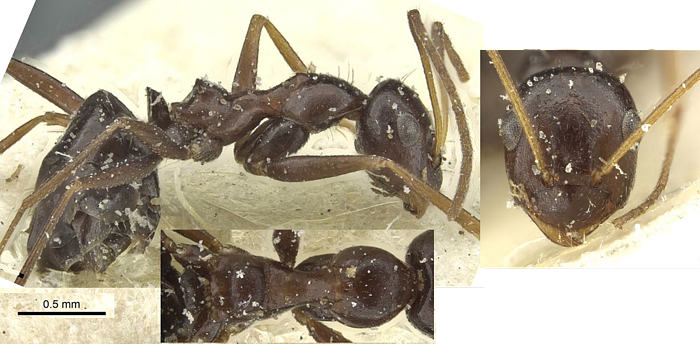
|
|
| -- |
 TL
2.6-3.2 mm; petiole with only shallow impression and angular corners
rather than spines; head, alitrunk and appendages dark brown-red, rest
lighter; KI 0.55 - 1.59 - 0.11 - 0.43 TL
2.6-3.2 mm; petiole with only shallow impression and angular corners
rather than spines; head, alitrunk and appendages dark brown-red, rest
lighter; KI 0.55 - 1.59 - 0.11 - 0.43
(Acantholepis frauenfeldi surchanica subsp. nov.,
Kuznetsov-Ugamsky, 1929c: 491, illustrated, worker) from Turkestan - no images on Antweb
(October 2014)
Kuznetsov-Ugamsky's (1929c) description of surchanica is on 
|
[ssp of frauenfeldi
in Bolton, 1995]
Turkestan - surchanica |
| -- |
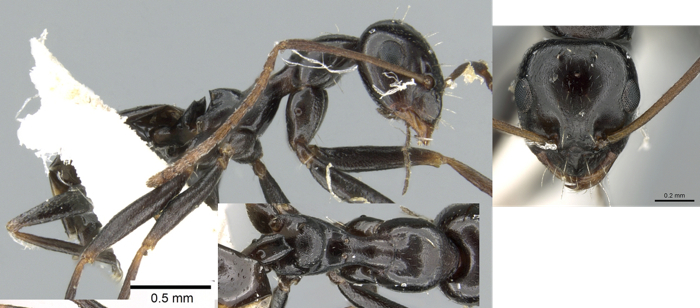 TL
2.5 mm; scapes long SI > 190; petiole narrower, very shiny;
propodeum with distinct spines; brown-black,
appendages more brown;
maximum width at less than twice the depth of the scale incision; from Crete -
non-type images at http://www.antweb.org/specimenImages.do?code=casent0906265 TL
2.5 mm; scapes long SI > 190; petiole narrower, very shiny;
propodeum with distinct spines; brown-black,
appendages more brown;
maximum width at less than twice the depth of the scale incision; from Crete -
non-type images at http://www.antweb.org/specimenImages.do?code=casent0906265
(Acantholepis frauenfeldi Mayr var splendens nova.,
Karavaiev,
1912b: 586, worker & queen; raised to species by Agosti &
Collingwood, 1987a: 57)
Karavaiev's (1912b) description is on  [Karavaiev, V.
1912.
Ameisen aus dem paläarktischen Faunengebiete. Russk. Entomol. Obozr.,
12, 581-596]
[Karavaiev, V.
1912.
Ameisen aus dem paläarktischen Faunengebiete. Russk. Entomol. Obozr.,
12, 581-596] |
 [sp splendens in
Bolton, 1995] [sp splendens in
Bolton, 1995]
Crete & Corfu and Egypt - splendens |
| -- |
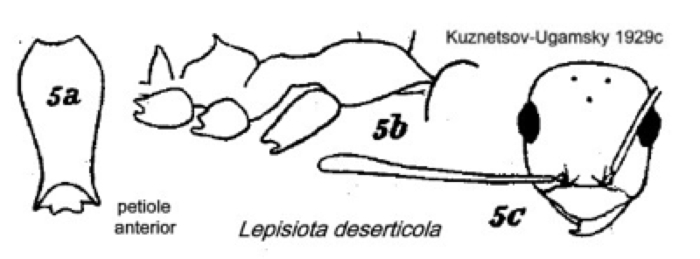 TL
2.8-3.2 mm; head square; very finely microscopically reticulate but
shiny; dark brown, alitrunk red, coxae dark black-brown; KI 0.58 - 1.62
- 0.18 - 0.34 TL
2.8-3.2 mm; head square; very finely microscopically reticulate but
shiny; dark brown, alitrunk red, coxae dark black-brown; KI 0.58 - 1.62
- 0.18 - 0.34
(Acantholepis frauenfeldi ssp deserticola,
Kuznetsov-Ugamsky, 1929c: 485, illustrated, worker); junior synonym of semenovi,
Dlussky, Soyunov & Zabelin, 1990: 165) from Turkestan - no images on Antweb
(September 2015)
Kuznetsov-Ugamsky's (1929c) description of deserticola is on 
|
[ssp of semenovi
in Bolton, 1995]
Turkmenistan - deserticola |
| -- |
 TL
2.8-3.2 mm; head square; very finely microscopically reticulate but
shiny; dark brown, alitrunk red, coxae dark black-brown; KI 0.68 - 1.77
- 0.38 - 0.57 TL
2.8-3.2 mm; head square; very finely microscopically reticulate but
shiny; dark brown, alitrunk red, coxae dark black-brown; KI 0.68 - 1.77
- 0.38 - 0.57
(Acantholepis frauenfeldi litoralis subsp. nov.,
Kuznetsov-Ugamsky, 1929c: 488, illustrated, worker); junior synonym of semenovi,
Dlussky, Soyunov & Zabelin, 1990: 165) from Turkestan - see http://www.antweb.org/specimenImages.do?code=casent0912406
Kuznetsov-Ugamsky's (1929c) description of litoralis is on 
|
[ssp
of semenovi in Bolton, 1995]
Turkmenistan - litoralis |
|
|
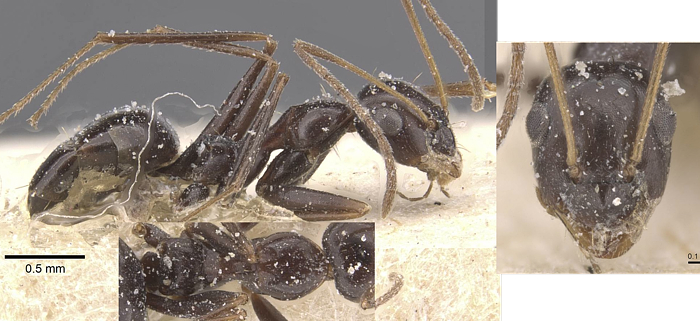 |
|
| -- |
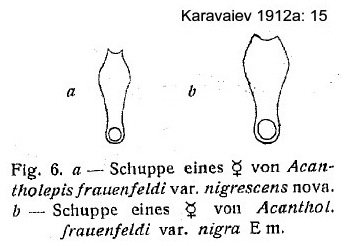 Black specimens
from desert areas with workers TL
2.8-3.0 mm Black specimens
from desert areas with workers TL
2.8-3.0 mm
(Acantholepis frauenfeldi var nigra Em., Dalla Torre,
1893:
171, all forms; species status Zimmermann, 1935: 45; confirmed by
Agosti & Collingwood, 1987a: 57) - Bolton (1995: 228) has this as
type location Italy (Capri)
but note the confusing entry by Emery (1878b) as "Persia settent. (Doria)".
Dalla Torre's (1893) paper simply provides a list of names; this is on  . .
The name nigra is ascribed to Emery (1878b: 46; 1881b: 527; and
it appears by letter to Dalla Torre) - this is on  . . |
|
| -- |
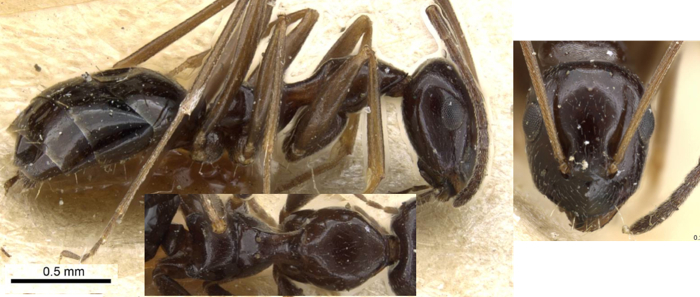 In his key, Finzi (1936: 188)
noted - petiole scale large (bipartita
type); maximum width at about about double the depth of the incision of
the scale. Tarbinsky (1976: 129) considered nigra and frauenfeldi
kassanasi (see above) providing illustrations of the nigra
sexual stages; the text, however, is in Russian In his key, Finzi (1936: 188)
noted - petiole scale large (bipartita
type); maximum width at about about double the depth of the incision of
the scale. Tarbinsky (1976: 129) considered nigra and frauenfeldi
kassanasi (see above) providing illustrations of the nigra
sexual stages; the text, however, is in Russian
Tarbinsky's (1976) description is at  . . |
 [sp nigra in Bolton,
1995] [sp nigra in Bolton,
1995]
Iran/Iraq and Egypt - nigra |
| -- |
 TL
2.6-3.2 mm; head near square, with distinctly convex sides; propodeal
spines short and broadly based; head and alitrunk finely granulate,
semi-matt, gaster shiny; generally black, some reddish areas on
alitrunk; KI 0.47- 1.37 - 0.23 - 0.52 TL
2.6-3.2 mm; head near square, with distinctly convex sides; propodeal
spines short and broadly based; head and alitrunk finely granulate,
semi-matt, gaster shiny; generally black, some reddish areas on
alitrunk; KI 0.47- 1.37 - 0.23 - 0.52
(Acantholepis frauenfeldi latisquama subsp. nov.,
Kuznetsov-Ugamsky, 1929c: 487, illustrated, worker; junior synonym of semenovi
by Dlussky, Soyunov & Zabelin, 1990: 165) from Turkestan - no
images on Antweb (September 2015)
Kuznetsov-Ugamsky's (1929c) description of latisquama is on 
|
[ssp
of semenovi in Bolton, 1995]
Turkestan - latisquama |
 |
--Petiole with distinct teeth or spines - frauenfeldi-group,
bipartita-group and karawaiewi-group |
. |
| 10 |
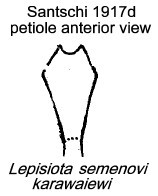 Petiole scale in anterior view a variably elongate hexagon Petiole scale in anterior view a variably elongate hexagon |
Primarily
east-central Asia species - bipartita-group - 11 |
| -- |
Petiole scale in anterior
view
variably elongate with smoothly arcuate sides |
frauenfeldii
group
- 15 |
|
Petiole scale in anterior view angular; in profile
scale relatively low and thick |
. |
| 11 |
Petiole
elongate; KI
b/a ca 0.68, f/a ca 0.40 |
karawaiewi-group
- 12 |
| -- |
Petiole relatively wide;
KI b/a <
0.68; f/a ca 1.00 |
bipartita-group
- 13 |
| 12 |
 TL
2.8-3.1 mm; generally smooth and shiny; overall colour black,
mid-alitrunk dark brown-red, appendages yellowish-brown; KI 0.68 - 1.86
- 0.45 - 0.86 TL
2.8-3.1 mm; generally smooth and shiny; overall colour black,
mid-alitrunk dark brown-red, appendages yellowish-brown; KI 0.68 - 1.86
- 0.45 - 0.86
(Acantholepis frauenfeldi mediorubra nov. subsp.,
Kuznetsov-Ugamsky, 1929c: 486, illustrated, worker; junior synonym of semenovi,
Dlussky, Soyunov & Zabelin, 1990: 163s)
from Turkestan - no images on
Antweb (September 2015)
Kuznetsov-Ugamsky's (1929c) description of mediorubra is on 
|
[ssp
of semenovi in Bolton, 1995]
Turkestan - mediorubra |
| -- |
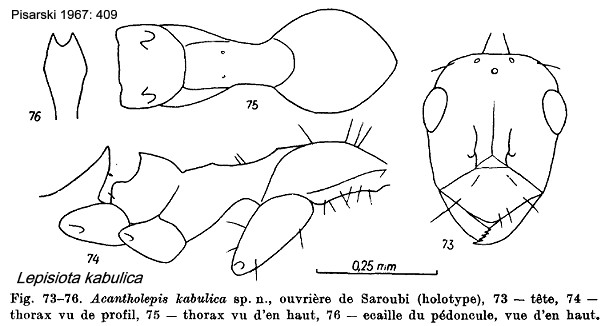 TL
3.0-3.5 mm; whole body finely reticulate and matt, pro- and mesonotum
slightly shiny; overall colour blackish-brown, funiculi and tasi
lighter, alitrunk reddish brown with dark patches TL
3.0-3.5 mm; whole body finely reticulate and matt, pro- and mesonotum
slightly shiny; overall colour blackish-brown, funiculi and tasi
lighter, alitrunk reddish brown with dark patches
As species in Bolton (1995: 227); (Acantholepis
kabulica sp. n., Pisarski, 1967: 409, illustrated,
worker) Afghanistan - see http://www.antweb.org/specimenImages.do?code=casent0912396
Pisarski's (1967) description is on 
|
 [sp in Bolton, 1995] [sp in Bolton, 1995]
Afghanistan - kabulica |
|
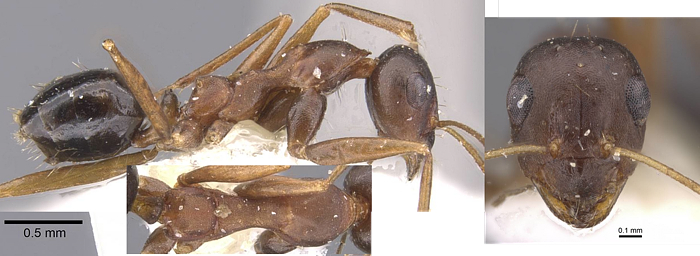
|
|
| -- |
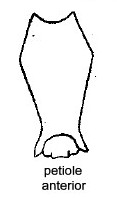 TL
2.8-3.0 mm; frontal notch of head well-marked; often with an elongated
groove on the pronotum alitrunk at least partly densely reticulate;
pilosity transparent; black, legs brown, mandibles and antennae clear
rust (Santschi, 1917d). KI 0.52 - 1.69 - 0.40 - 0.75 TL
2.8-3.0 mm; frontal notch of head well-marked; often with an elongated
groove on the pronotum alitrunk at least partly densely reticulate;
pilosity transparent; black, legs brown, mandibles and antennae clear
rust (Santschi, 1917d). KI 0.52 - 1.69 - 0.40 - 0.75
(Acantholepis frauenfeldi stirps melas var karawaiewi
n. v.,
Sanstchi, 1917d: 44; Acantholepis frauenfeldi ssp
karawaiewi, Kuznetsov-Ugamsky, 1929c: 483, worker; raised to
species Pisarski, 1967; junior synonym of semenovi, Dlussky,
Soyunov & Zabelin, 1990: 163) from Turkestan
- see http://www.antweb.org/specimenImages.do?code=casent0912405
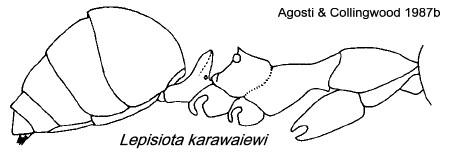 Kuznetsov-Ugamsky's
(1929c) description of karawaiewi with variety minuta
is on Kuznetsov-Ugamsky's
(1929c) description of karawaiewi with variety minuta
is on 
|
[ssp
of semenovi in Bolton, 1995]
Turkestan - karawaiewi |
|
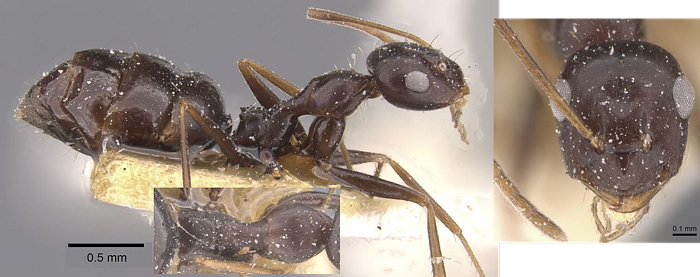
|
|
|
Petiole scale in anterior view angular but about as
wide as it is high |
. |
| 13 |
 TL 3.0-3.5 mm; slender; red, gaster black TL 3.0-3.5 mm; slender; red, gaster black
(Acantholepis frauenfeldi var melanogaster n., Emery
1915h:
4, worker; Karavaiev, 1926e: 189, queen & male; stirps of frauenfeldi
in Santschi, 1917d: 47 [key]; raised to species, Pisarsky, 1967: 410;
Arnold'i & Dlussky, 1978: 551 {in key]) from Turkestan.
[3873 Emery, C. 1915. Escursioni zoologiche del Dr. Enrico Festa
nell'Isola di Rodi. XII. Formiche. Boll. Mus. Zool. Anat. Comp. R.
Univ. Torino 30, 1-7.]
Emery's (1915h) description is on  Pisarski
(1967: 410
noted bipartita of Karavaiev, 1910b [see below] in part. See http://www.antweb.org/specimenImages.do?code=casent0905147
Pisarski
(1967: 410
noted bipartita of Karavaiev, 1910b [see below] in part. See http://www.antweb.org/specimenImages.do?code=casent0905147
|
 [sp in Bolton, 1995] [sp in Bolton, 1995]
Transcaucasia - melanogaster |
| -- |
 TL 2.5-3.0 mm
(3.0-3.5 mm, Karavaiev from Transcaspasia);
alitrunk subopaque; head weakly shiny; colour head and alitrunk
reddish, gaster brown (scapes surpass occiput by 3/5 own length, Forel
1894c: 411) TL 2.5-3.0 mm
(3.0-3.5 mm, Karavaiev from Transcaspasia);
alitrunk subopaque; head weakly shiny; colour head and alitrunk
reddish, gaster brown (scapes surpass occiput by 3/5 own length, Forel
1894c: 411)
|
[ssp
of frauenfeldi
in Bolton, 1995]
"Eastern Persia" (Forel, 1904)
Lebanon - bipartita
|
| -- |
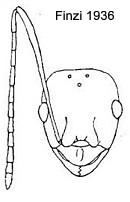
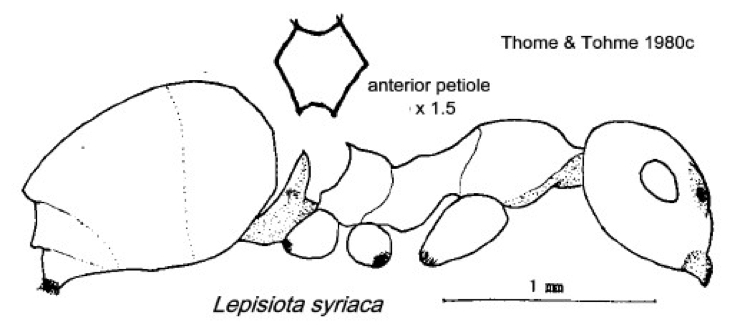 TL
2.0-3.2 mm; petiole scale acutely dentate; propodeum with short teeth
about than 0.5 X basal space; clypeus with weaker median carina;
less shiny but finely and distinctly reticulate; alitrunk black with no
more than mesonotum red TL
2.0-3.2 mm; petiole scale acutely dentate; propodeum with short teeth
about than 0.5 X basal space; clypeus with weaker median carina;
less shiny but finely and distinctly reticulate; alitrunk black with no
more than mesonotum red
André (1882b: 211) noted this variety as from Beirut with a small size;
close to bipartita in colour and appearance. However, its
behaviour ("allures") is quite different and the queens are distinct
from those of the type and of bipartita
(Acantholepis frauenfeldi ssp syriaca, André, 1881b: 61,
illustrated [Plate unavailable], all forms; raised to species by Tohmé
& Tohmé, 1980c: 518) from Lebanon,
Beirut
André's (1881b) description of syriaca is on  Finzi's (1936: 185) illustrated description of syriaca is on
Finzi's (1936: 185) illustrated description of syriaca is on 
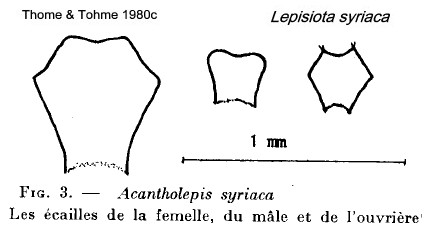 Tohmé & Tohmé
(1980c) reviewed the status and
described the sexual stages; this is at Tohmé & Tohmé
(1980c) reviewed the status and
described the sexual stages; this is at  . .
Reference is made to - Tohmé & Tohmé 1975. Description des castes d'Acantholpeis
frauenfeldi, Mayr et des différents stades larvaires. Bull.
Soc. ent. Egypte, 59, 131-141 - not listed in Bolton (1995)
nor in HNS - no images on Antweb (September 2015)
|
 [sp in Bolton, 1995] [sp in Bolton, 1995]
Lebanon - syriaca |
|
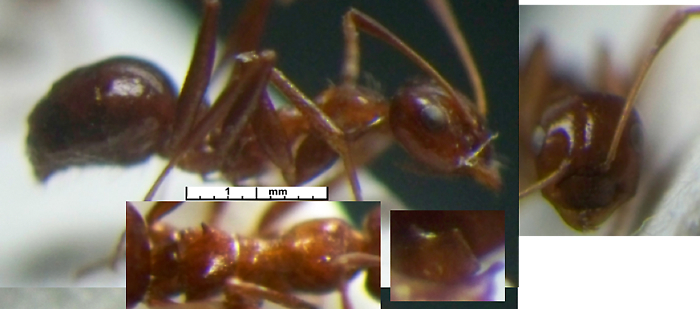
|
|
| - |
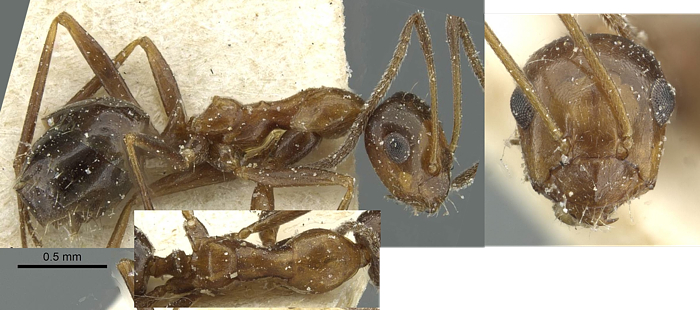 TL
2.3-3.6 mm;
close to bipartita but - alitrunk shinier and less sulptured;
propodeum also shinier, spines sharp; clear red, gaster black-brown
often basally rusty TL
2.3-3.6 mm;
close to bipartita but - alitrunk shinier and less sulptured;
propodeum also shinier, spines sharp; clear red, gaster black-brown
often basally rusty
(Acantholepis frauenfeldi var caucasica n. v., Santschi,
1917d: 43, worker; raised to species by Agosti & Collingwood,
1987a: 57; synonym of frauenfeldi,
Arakelian, 1994: 81) from Caucasus
- no images on Antweb
(September 2015) |
[junior
synonym of frauenfeldi
in Bolton, 1995]
Caucasus - caucasica |
| - |
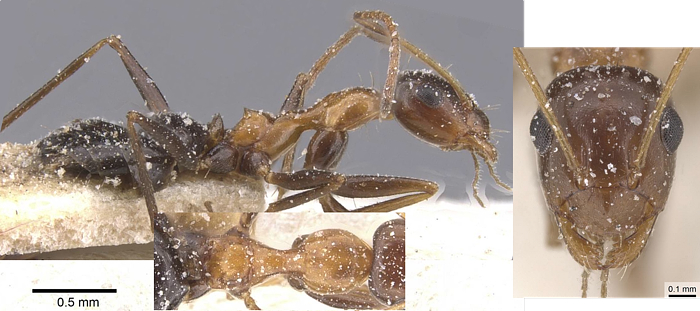 TL 3.0-3.5 mm (3.2-3.6 mm Kuznetsv); close
to bipartita but much shinier and smoother; head and femora
often darker, brown to blackish-brown (specimens from Karavaiev) TL 3.0-3.5 mm (3.2-3.6 mm Kuznetsv); close
to bipartita but much shinier and smoother; head and femora
often darker, brown to blackish-brown (specimens from Karavaiev)
(Acantholepis frauenfeldi v. transcaspiensis n. var.,
Santschi,
1917d: 43, worker; Karavaiev, 1926e: 188, queen & male) from Russia - see http://www.antweb.org/specimenImages.do?code=casent0912408
|
[ssp
of semenovi in Bolton, 1995]
Russia - transcaspiensis |
|
Petiole scale in anterior view variably elongate with
smoothly arcuate sides |
. |
| 14 |
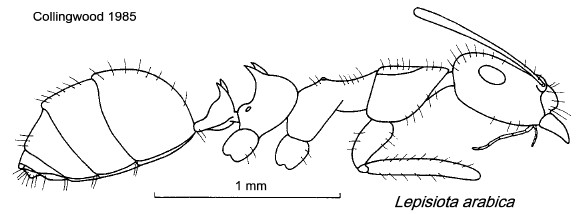 TL
3.5; head oval with rounded sides and a straight occipitum; pronotum
flattened medially; propodeal spines long and curved, petiole
spines very long; head shiny, propodeum sculptured, gaster
brilliant; scattered short black erect hairs, on head extending around
the eye; head and alitrunk clear red, gaster dark but with base of
first tergite testaceous, appendages brown to pale red (Collingwood
1985: 293, illustrated, worker) from Saudi
Arabia - see http://www.antweb.org/specimenImages.do?code=casent0912368 TL
3.5; head oval with rounded sides and a straight occipitum; pronotum
flattened medially; propodeal spines long and curved, petiole
spines very long; head shiny, propodeum sculptured, gaster
brilliant; scattered short black erect hairs, on head extending around
the eye; head and alitrunk clear red, gaster dark but with base of
first tergite testaceous, appendages brown to pale red (Collingwood
1985: 293, illustrated, worker) from Saudi
Arabia - see http://www.antweb.org/specimenImages.do?code=casent0912368
|
 [sp in Bolton, 1995] [sp in Bolton, 1995]
Saudi Arabia - arabica |
|

|
|
| -- |
Propodeum and petiole with
short
straight spines; also in profile quite high and slender alitrunk partly
red or entirely black; dorsum with scattered fine pale hairs most on
pronotum |
15 |
| 15 |
Pronotum
obviously
convex |
16 |
| -- |
Pronotum flat or no more
than slightly
convex |
frauenfeldi-group
- 18 |
| 16 |
 TL
2.2-2.5 mm; head slightly flattened with occiput near straight;
pronotum obviously convex; petiole scale scalloped, bidentate with
sides angular; erect hairs scarce and yellowish; pubescence very short
and transparent; very smooth and shiny, mesonotum slightly reticulate;
head, femora and gaster brownish-black, alitrunk red, with a slight
brown area on mesonotum; appendages also red; shinier than type frauenfeldi
with pronotum more convex TL
2.2-2.5 mm; head slightly flattened with occiput near straight;
pronotum obviously convex; petiole scale scalloped, bidentate with
sides angular; erect hairs scarce and yellowish; pubescence very short
and transparent; very smooth and shiny, mesonotum slightly reticulate;
head, femora and gaster brownish-black, alitrunk red, with a slight
brown area on mesonotum; appendages also red; shinier than type frauenfeldi
with pronotum more convex
(Acantholepis frauenfeldi var atlantis n. var.,
Santschi, 1917d:
42, worker & queen) from Algeria
- see http://www.antweb.org/specimenImages.do?code=casent0912379
|
[ssp
of frauenfeldi in Bolton, 1995]
Algeria & Tunisia - atlantis |
| -- |
Alitrunk wholly black (?) |
17 |
| 17 |
 TL
2.8-3.6 mm; petiole scale acutely dentate; propodeum with short stout
spines, more than 0.75 X basal space; alitrunk entirely black;
KI 0.58 - 2.00 - 0.55 - 0.54 TL
2.8-3.6 mm; petiole scale acutely dentate; propodeum with short stout
spines, more than 0.75 X basal space; alitrunk entirely black;
KI 0.58 - 2.00 - 0.55 - 0.54
|
|
| . |
 |
[ssp
of semenovi in Bolton, 1995]
Turkestan - spinisquama |
| -- |
 TL
3.0-3.3 mm; petiole scale acutely dentate; propodeum with long thin
curved spines, more than 0.75 X basal space; KI 0.53 - 1.71 - 0.21 -
0.50 TL
3.0-3.3 mm; petiole scale acutely dentate; propodeum with long thin
curved spines, more than 0.75 X basal space; KI 0.53 - 1.71 - 0.21 -
0.50
(Acantholepis frauenfeldi turkmena nov. subsp.,
Kuznetsov-Ugamsky, 1929c: 488, illustrated, worker; junior synonym of semenovi,
Dlussky, Soyunov & Zabelin, 1990: 163) from Turkestan
unavailable name infumata (Acantholepis frauenfeldi turkmena
var. turkmena nov. var.,
Kuznetsov-Ugamsky, 1929c: 488, worker; referred to semenovi by
Dlussky, Soyunov & Zabelin, 1990: 163) from Turkestan
Kuznetsov-Ugamsky's (1929c) description of turkmena with
variety infumata is on  No images on Antweb (September 2015)
No images on Antweb (September 2015)
|
[ssp of semenovi
in Bolton, 1995]
Turkestan - turkmena |
| -- |
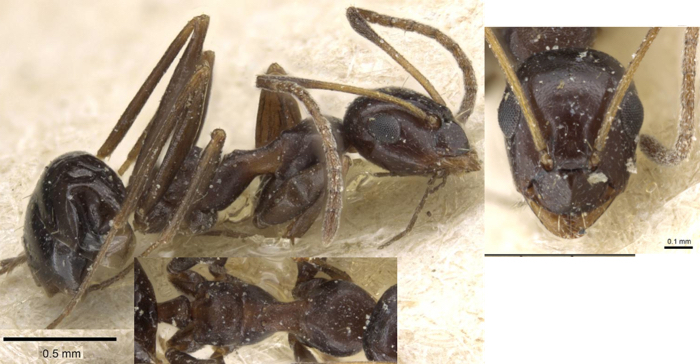 TL
not stated; alitrunk minutely transversely striated and more or
less flat; petiole with sharp spine like teeth TL
not stated; alitrunk minutely transversely striated and more or
less flat; petiole with sharp spine like teeth
(Acantholepis frauenfeldi Mayr var melas n., Emery,
1915h: 3,
worker; Finzi, 1932: 25, queen; Finzi, 1939c: 158, male; stirps of frauenfeldi
in Santschi, 1917d: 44; raised to species by Agosti & Collingwood,
1987a: 57, name only) Rhodes, Greece -
images from http://www.antweb.org/specimenImages.do?code=casent0905146
Emery's (1915h) description is on 
|
 [sp in Bolton, 1995] [sp in Bolton, 1995]
Greece - Rhodes I. (also Turkestan?) - melas |
|
Pronotum
near flat |
. |
| 18 |
Petiole
with almost
straight sides, quite deeply impressed summit but with angles obtuse
and not sharply spinose |
19 |
| -- |
Petiole with curved sides
and sharp
spines |
20 |
| . |
frauenfeldi-subgroup
clypeus strongly carinate; eyes large, variably convex |
. |
| 19 |
 TL
2.0-3.2 mm; scapes surpass occiput by about 0.5 of own length; petiole
scale acutely dentate; propodeum with short teeth about 0.5 X basal
space; clypeus with strong median carina; shiny but finely and
distinctly reticulate; alitrunk black with no more than mesonotum red TL
2.0-3.2 mm; scapes surpass occiput by about 0.5 of own length; petiole
scale acutely dentate; propodeum with short teeth about 0.5 X basal
space; clypeus with strong median carina; shiny but finely and
distinctly reticulate; alitrunk black with no more than mesonotum red
Forel (1894c) had - TL 2.5-2.8 mm; head oval-rectangular, slightly
enlarged posteriorly; scapes surpass occiput by no more than half their
own length; very shiny almost smooth; head and appendages brown to
yellow, alitrunk yellowish-red, gaster brown-black
(Hypoclinea Frauenfeldi n. sp., Mayr, 1855: 378, worker; Roger,
1859:
243, queen; Emery, 1878b: 46, male) from Dalmatia, Croatia
Mayr's (1855) description is on  .
Thomé &
Thomé (1975) described all
life stages of what they regarded as frauenfeldi; this is at .
Thomé &
Thomé (1975) described all
life stages of what they regarded as frauenfeldi; this is at  .
However, they do not refer at all to Mayr's original description. .
However, they do not refer at all to Mayr's original description. 
André (1884: 179, on European ants) had - black brown, brilliant,
almost glabrous, covered with superficial and very fine striations
("rides"); mandibles, antennae except the apex of the scape, alitrunk,
articulations of the femora and tarsi reddish yellow; often the
alitrunk has several brown patches; this colour pattern seems to match
that given by Mayr and the type worker.
The non-type shown in the thumbnail is from close to the type location
and is collated from https://www.antweb.org/specimenImages.do?code=casent0906081
|
 [sp in Bolton, 1995] [sp in Bolton, 1995]
frauenfeldi |
| . |
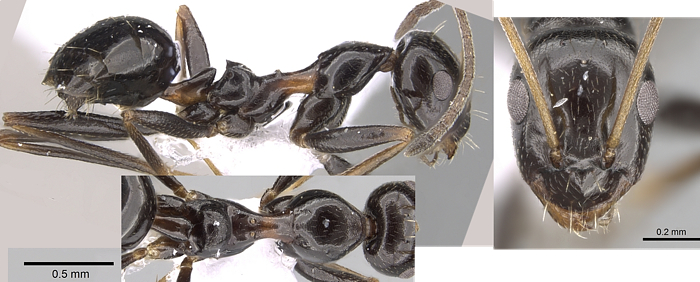 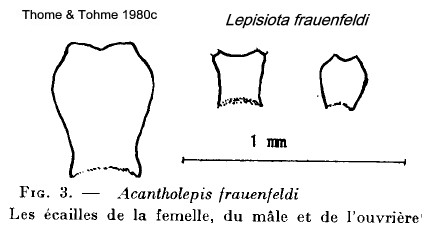 |
|
| . |
 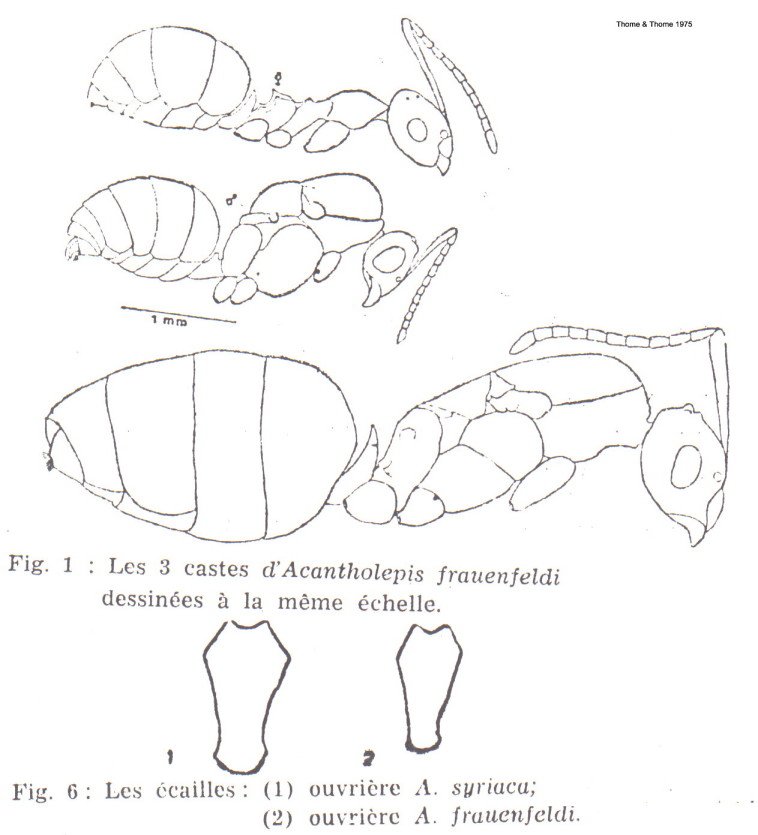 |
|
| -- |
 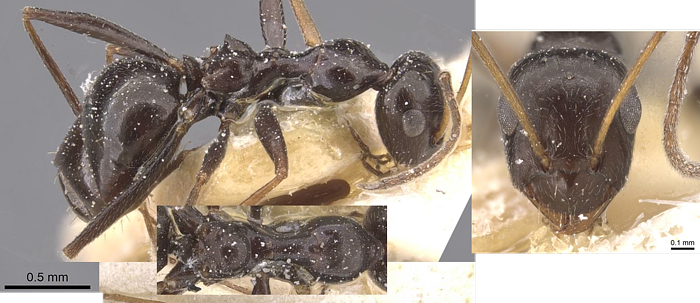 TL 2.5-2.7
mm; petiole scale narrowly rounded with shallow incision, less so than atlantis
and narrower than nigra or bipartita; dark red of
mesonotum approaching black, especially on montane examples
(melanistic) TL 2.5-2.7
mm; petiole scale narrowly rounded with shallow incision, less so than atlantis
and narrower than nigra or bipartita; dark red of
mesonotum approaching black, especially on montane examples
(melanistic)
(Acantholepis fraunenfeldi Mayr var. nigrescens nova,
Karavaiev,
1912a: 15, illustrated, worker [unavailable]; Menozzi, 1927g: 380,
queen; raised to species by Collingwood, 1985: 295; name misspelt as nigrans
by Santschi,1917d: 43) - see http://www.antweb.org/specimenImages.do?code=casent0912400
Karavaiev's (1912a) description is on 
|
 [sp in Bolton, 1995] [sp in Bolton, 1995]
Algeria, Tunisia & Libya - nigrescens |
| -- |
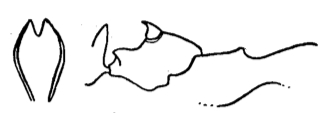 Acantholepis frauenfeldi var. variabilis
n. var., similar;
TL 2.0-3.4 mm but very variable within one nest (Santschi, 1917d: 43,
worker) from Tunisia - type
images at http://www.antweb.org/specimenImages.do?code=casent0912387
appear identical to the frauenfeldi type
form Acantholepis frauenfeldi var. variabilis
n. var., similar;
TL 2.0-3.4 mm but very variable within one nest (Santschi, 1917d: 43,
worker) from Tunisia - type
images at http://www.antweb.org/specimenImages.do?code=casent0912387
appear identical to the frauenfeldi type
form
|
[ssp
of frauenfeldi in Bolton, 1995]
Algeria, Tunisia & Libya - variabilis |
|
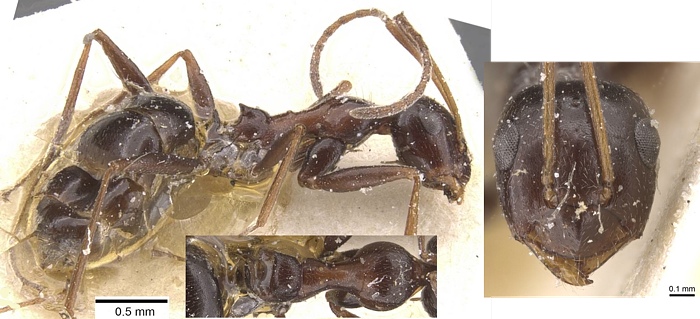
|
|
|
Petiole
scale with arcuate sides |
. |
| 20 |
Petiole
scale weakly
subdentate |
21 |
| -- |
Petiole scale laterally
with short
sharp spines |
22 |
| 21 |
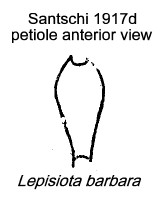 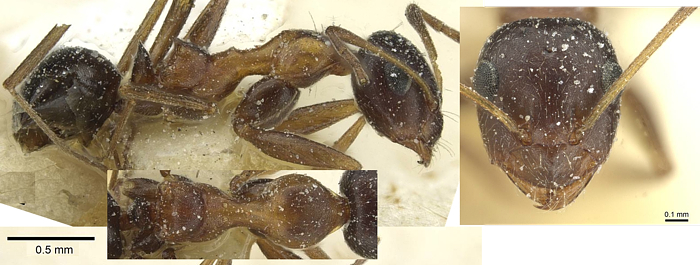 TL 2.8-3.0 mm; colour as bipartita
but head usually darker; sculpture less pronounced and shinier but less
finely reticulate than caucasica; propodeum more robust than
latter, higher and more sculptured; differs primarily by the more
deeply excavated petiole - see http://www.antweb.org/specimenImages.do?code=casent0912380 TL 2.8-3.0 mm; colour as bipartita
but head usually darker; sculpture less pronounced and shinier but less
finely reticulate than caucasica; propodeum more robust than
latter, higher and more sculptured; differs primarily by the more
deeply excavated petiole - see http://www.antweb.org/specimenImages.do?code=casent0912380
(Acantholepis frauenfeldi v. barbara n. var., Santschi,
1917d:
44, illustrated,worker) from Tunisia |
[ssp
of frauenfeldi in Bolton, 1995]
Tunisia - barbara |
| -- |
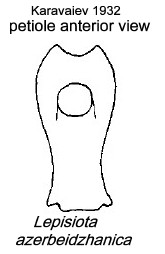 TL 2.5-3.0 mm; generally dark brown with black gaster TL 2.5-3.0 mm; generally dark brown with black gaster
(Acantholepis frauendfeldi Mayr var. azerbeidzhanica nov., Karavaiev,
1932: 250,
illustrated, worker; synonymy Arakelian, 1994: 81) from Azerbaijan - no images on Antweb
(September 2015)
Karavaiev's (1932) description of azerbeidzhanica is on 
|
[junior
synonym of frauenfeldi
in Bolton, 1995]
Azerbaijan - azerbeidzhanica |
|
Petiole
scale relatively short, sub-ovoid with sharp teeth (broad based) |
. |
| 22 |
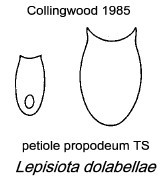 TL
3.5-3.8 mm; head enlarged posteriorly, as wide as long and slightly
flattened; pronotum also flattened and wide (as with pubescens
but the pubescence is as in the type form frauenfeldi and also
shiny); propodeum with fairly obtuse teeth; scale without spines,
the summit feebly impressed; alitrunk red except pronotum, petiole
basally red and brown apically, remainder of body brown black,
appendages more or less rust (Forel, 1911d). Found alongside frauenfeldi. TL
3.5-3.8 mm; head enlarged posteriorly, as wide as long and slightly
flattened; pronotum also flattened and wide (as with pubescens
but the pubescence is as in the type form frauenfeldi and also
shiny); propodeum with fairly obtuse teeth; scale without spines,
the summit feebly impressed; alitrunk red except pronotum, petiole
basally red and brown apically, remainder of body brown black,
appendages more or less rust (Forel, 1911d). Found alongside frauenfeldi.
Petiole scale acutely dentate; propodeum with short teeth about 0.5 X
basal space; alitrunk finely sculptured; bicoloured, head and gaster
dark contrasting with red alitrunk (Collingwood, 1985); propodeum
bluntly dentate, legs and antennae dark (Collingwood & Agosti, 1996
key) - these notes appear to differ significantly from the original
Forel description
(Acantholepis Frauenfeldi Mayr v. Dolabellae n. var.,
Forel, 1911d:
351, worker; raised to species by Collingwoood, 1985: 294) from Turkey
Forel's (1911d) description is on 
|
. |
|
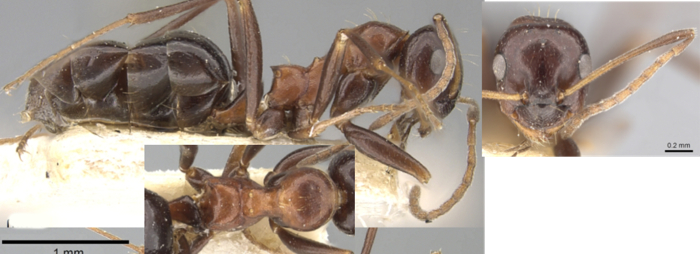 |
 [sp in Bolton, 1995] [sp in Bolton, 1995]
common Middle East species - dolabellae |
| -- |
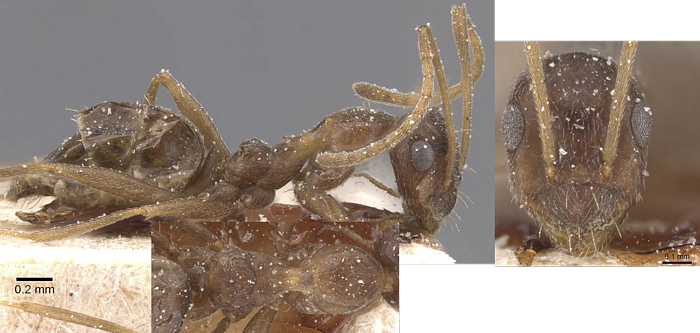 TL
2.5-3.0 mm;
very close to frauenfeldi but head somewhat longer and
occipitum narrower; scape surpasses occiput by almost 2/3 own length;
alitrunk longer and more slender; propodeal tubercle with short teeth;
petiole scale oval, and bispinose but more narrowly than in bipartita
body less shiny TL
2.5-3.0 mm;
very close to frauenfeldi but head somewhat longer and
occipitum narrower; scape surpasses occiput by almost 2/3 own length;
alitrunk longer and more slender; propodeal tubercle with short teeth;
petiole scale oval, and bispinose but more narrowly than in bipartita
body less shiny
(more matt than syriaca.
(Acantholpeis Frauenfeldi Mayr v. libanica n. v.,
Santschi, 1921a:
115, worker) from Syria - see
http://www.antweb.org/specimenImages.do?code=casent0912383
Santschi's (1932) description of libanica is on  |
[ssp of frauenfeldi
in Bolton, 1995]
Lebanon & Syria - libanica |
Translation of the Santschi (1917d)
key -
| 1 |
Petiole scale edentate; with summit
straight
widely truncate or very lightly impressed |
2 [37] - integra-group |
| - |
Petiole scale oval, narrowed at the
summit,
usually bidentate or bispinose |
5 |
| . |
Petiole edentate
with summit
straight or near so |
. |
| 2 [37] |
Black shiny, petiole unarmed |
Indian subcontinent
- st integra |
| - |
Alitrunk more or less red |
Africa - 3
|
| 3 |
TL 3.2-3.8 mm; petiole of queen
entire and narrow |
Tunisia - integra var
velox |
| - |
TL less |
4 |
| 4 |
TL 2.6-2.8 mm |
Tunisia - integra var
truncata |
| - |
TL 1.6-2.2 mm |
Tunisia - integra var
minima |
| . |
Petiole scale
oval, narrowed
at the summit, usually bidentate or bispinose |
|
| 5 [2] |
Alitrunk matt or submatt or only
mostly matt
when rest is black |
6 [26] |
| - |
Alitrunk shiny or greatly shiny, in
latter case
red or partly red |
20 [4] |
| . |
Alitrunk matt or
submatt or
only mostly matt when rest is black |
|
| 6 [26] |
Alitrunk black |
7 [34] |
| - |
Alitrunk red (and shiny?) |
8 [3] |
| 7 [34] |
Parts of alitrunk very finely
striated
transversely, more or less matt |
Asia Minor, Rhodes
- st melas |
| - |
Whole or part of alitrunk densely
reticulate,
frontal notch well defined, often a similar longitudinal notch on the
pronotum (male rust) |
Turkestan - st melas
v karwaiewi |
| . |
Alitrunk red &
shiny |
|
| 8 [28] |
Head and appendages blackish, head
very shiny |
Asia Minor - stirps dolabellae |
| - |
Head and appendages reddish or head
matt |
9 [30] |
| 9 [30 |
Head vertex shiny, petiole sides
smoothly
curved; erect pilosity rare but yellow |
Israel - stirps bipartita |
| - |
Head matt and darker |
10 [32] |
| 10 [32[ |
Petiole widely impressed, sides
angular (as karawaiewi);
TL 2.5-2.8 mm; pilosity yellow |
Indian subcontinent
- v sericea
|
| - |
Petiole more narrowly impressed,
sides not
angular; TL 2.8-3.0 mm; erect pilosity brown |
Southern Algeria -
v kantarensis |
| . |
Alitrunk shiny or
greatly
shiny, in latter case red or partly red |
|
| 11 [3] |
Alitrunk always black in all
individuals;
occiput convex; shiny, petiole bidentate but not spinose |
12 [23a] |
| - |
Alitrunk entirely or partly red,
sometimes with
alitrunk of some individuals completely black, but in that case the
petiole is bispinose and the head widened occipitally, occiput
shallowly convex |
13 [4] |
| . |
Alitrunk always
black |
|
| 12[23a] |
Petiole wide (as in bipartita),
shiny |
Italy - v nigra |
| - |
Petiole narrower (as in nigrescens),
very shiny |
Crete & Corfu -
v splendens |
| . |
Alitrunk in most
specimens at
least partly red |
|
| 13 [4] |
Alitrunk partly dark with the
central area more
or less red; if whole of alitrunk red then the head is brown black |
14 [5] |
| - |
Alitrunk entirely red; head and legs
reddish |
20 [17] |
| - |
Alitrunk partly
dark and/or
head brown black |
|
| 14 [5] |
TL max 3.2 mm |
15 [6] |
| - |
TL 3.2-4.0 mm |
19 [14] |
| . |
TL max 3.2 mm |
|
| 15 [6] |
Pronotum slightly depressed, near
flat |
16 [7] |
| - |
Pronotum clearly convex, slightly
bordered, very
shiny |
17 [10] |
| . |
Pronotum flat |
. |
| 16 [7] |
Shiny, finely but distinctly
reticulate; clypeus
with strong median carina |
Dalmatia &
Crete - sp frauenfeldi |
| - |
less shiny, clypeus with less
distinct carina |
Lebanon - v syriaca |
| . |
Pronotum clearly
convex,
slightly bordered, very shiny |
. |
| 17 [10] |
Alitrunk red, with a single brown
area on the
mesonotum; head and femora brown-black [petiole of queen with deeply
impressed margin] |
Algeria &
Tunisia - v atlantis |
| - |
Mesonotum reddish or dark red,
remainder black |
18 [11] |
| 18 [11] |
TL hardly variable 2.5-2.7 mm;
petiole scale
narrow |
(nigricans
Algeria &
Tunisia - v nigrescens |
| - |
TL very variable in same nest
2.0-3.4 mm |
Tunisia ? - v variabilis |
| . |
TL 3.2-4.0 mm |
|
| 19 [14] |
Occiput convex; petiole scale
bidentate (bipartita
type); alitrunk red; head at least dark brown; pubescence short and
sparse |
Transcaspia - v transcaspiensis |
| - |
Head wider, occiput slightly convex;
petiole
bispinose; alitrunk black, midarea often dark red; pubescence abundant |
Southern Tunisia -
stirps pubescens |
| . |
Alitrunk entirely
red; head
and legs reddish |
|
| 20 [17] |
Petiole regularly oval, very
narrowly truncate
or impressed at the summit |
Sahara - stirps saharensis |
| - |
Petiole wide and more deeply
impressed apically |
21 [19] |
| 21 [19] |
TL 3.0-3.5 mm; petiole scale with
angular sides;
quite smooth; red, gaster black |
Transcaucasia -
stirps melanogaster |
| - |
TL 2.0-3.0 mm; petiole scale with
sides not
angular; head sometimes brownish-red; alitrunk partly clearly
reticulate, fairly shiny |
22 [22] |
| 22 [22] |
TL 2.4-2.6 mm; petiole of bipartita type;
propodeum smooth and shiny, finely dentate |
Caucasus - v caucasica |
| - |
TL 2.6-2.8 mm; petiole more narrowly
impressed
but less so than saharensis; propodeum submatt, reticulate and
strongly dentate |
Tunisia - v barbara |
|
 Main Egypt Lepisiota
page
Main Egypt Lepisiota
page Main Egypt Lepisiota
page
Main Egypt Lepisiota
page